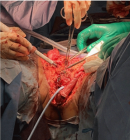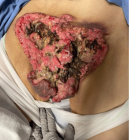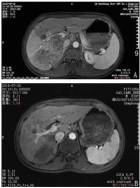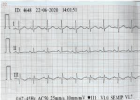Abstract
Case Report
Case – Late Presentation of Invasive Keratinizing Squamous Cell Carcinoma
Maximilien Laviolette-Brassard* and Le Mai Tu
Published: 27 December, 2023 | Volume 7 - Issue 3 | Pages: 080-082
Penile cancer, a rare but highly morbid disease, primarily manifests as squamous cell carcinoma (PSCC) originating from the squamous cells of the glandular and preputial skin. Late-stage diagnosis is common due to social stigma, psychological barriers, and nonspecific initial symptoms, resulting in poor overall survival rates, especially in metastatic cases. This case report illustrates a 38-year-old man with advanced metastatic PSCC, showcasing severe systemic manifestations and delayed presentation of the disease. Despite aggressive treatment options, the patient opted for palliative care, succumbing to the disease months after his diagnosis.
Risk factors for PSCC include HPV infection, phimosis, chronic inflammation, and lifestyle factors, with higher prevalence in regions of low socioeconomic status. The psychological and sexual burden of penile cancer is significant, impacting patients’ well-being, mental health, and quality of life.
In conclusion, efforts to reduce the stigma associated with penile cancer are crucial to prompt early diagnosis and treatment initiation. Encouraging seeking medical attention for symptoms can enhance the chances of recovery and minimize the need for invasive treatments. Addressing the psychosocial impact of the disease is imperative for holistic patient care.
Read Full Article HTML DOI: 10.29328/journal.acr.1001084 Cite this Article Read Full Article PDF
Keywords:
Penile cancer; Squamous cell carcinoma; Diagnosis, Metastatic; Screening; Stigma; Quality of life; Risk factors
References
- Montes Cardona CE, García-Perdomo HA. Incidence of penile cancer worldwide: systematic review and meta-analysis. Rev Panam Salud Publica. 2017 Nov 30;41:e117. doi: 10.26633/RPSP.2017.117. PMID: 31384255; PMCID: PMC6645409.
- Thomas A, Necchi A, Muneer A, Tobias-Machado M, Tran ATH, Van Rompuy AS, Spiess PE, Albersen M. Penile cancer. Nat Rev Dis Primers. 2021 Feb 11;7(1):11. doi: 10.1038/s41572-021-00246-5. PMID: 33574340.
- Cubilla AL, Reuter V, Velazquez E, Piris A, Saito S, Young RH. Histologic classification of penile carcinoma and its relation to outcome in 61 patients with primary resection. Int J Surg Pathol. 2001 Apr;9(2):111-20. doi: 10.1177/106689690100900204. PMID: 11484498.
- Cubilla, A. L., Velazquez, E. F., Amin, M. B., Epstein, J., Berney, D. M., Corbishley, C. M., & Panel, M. of the I. P. T. (2018). The World Health Organisation 2016 classification of penile carcinomas: A review and update from the International Society of Urological Pathology expert-driven recommendations. Histopathology, 72(6), 893–904. https://doi.org/10.1111/his.13429
- Djajadiningrat RS, Graafland NM, van Werkhoven E, Meinhardt W, Bex A, van der Poel HG, van Boven HH, Valdés Olmos RA, Horenblas S. Contemporary management of regional nodes in penile cancer-improvement of survival? J Urol. 2014 Jan;191(1):68-73. doi: 10.1016/j.juro.2013.07.088. Epub 2013 Aug 2. PMID: 23917166.
- Lucky MA, Rogers B, Parr NJ. Referrals into a dedicated British penile cancer centre and sources of possible delay. Sex Transm Infect. 2009 Dec;85(7):527-30. doi: 10.1136/sti.2009.036061. Epub 2009 Jul 6. PMID: 19584061.
- Stecca CE, Alt M, Jiang DM, Chung P, Crook JM, Kulkarni GS, Sridhar SS. Recent Advances in the Management of Penile Cancer: A Contemporary Review of the Literature. Oncol Ther. 2021 Jun;9(1):21-39. doi: 10.1007/s40487-020-00135-z. Epub 2021 Jan 16. PMID: 33454930; PMCID: PMC8140030.
- Skeppner E, Andersson SO, Johansson JE, Windahl T. Initial symptoms and delay in patients with penile carcinoma. Scand J Urol Nephrol. 2012 Oct;46(5):319-25. doi: 10.3109/00365599.2012.677473. Epub 2012 Jul 2. PMID: 22989150.
- Vieira CB, Feitoza L, Pinho J, Teixeira-Júnior A, Lages J, Calixto J, Coelho R, Nogueira L, Cunha I, Soares F, Silva GEB. Profile of patients with penile cancer in the region with the highest worldwide incidence. Sci Rep. 2020 Feb 19;10(1):2965. doi: 10.1038/s41598-020-59831-5. PMID: 32076037; PMCID: PMC7031540.
- Pagliaro LC, Crook J. Multimodality therapy in penile cancer: when and which treatments? World J Urol. 2009 Apr;27(2):221-5. doi: 10.1007/s00345-008-0310-z. Epub 2008 Aug 6. PMID: 18682961; PMCID: PMC4164341.
- Dräger DL, Milerski S, Sievert KD, Hakenberg OW. Psychosoziale Auswirkungen bei Patienten mit Peniskarzinom : Ein systematischer Überblick [Psychosocial effects in patients with penile cancer : A systematic review]. Urologe A. 2018 Apr;57(4):444-452. German. doi: 10.1007/s00120-018-0603-9. PMID: 29476193.
- Dräger DL, Protzel C, Hakenberg OW. Identifying Psychosocial Distress and Stressors Using Distress-screening Instruments in Patients With Localized and Advanced Penile Cancer. Clin Genitourin Cancer. 2017 Oct;15(5):605-609. doi: 10.1016/j.clgc.2017.04.010. Epub 2017 Apr 21. PMID: 28499559.
- Maddineni SB, Lau MM, Sangar VK. Identifying the needs of penile cancer sufferers: a systematic review of the quality of life, psychosexual and psychosocial literature in penile cancer. BMC Urol. 2009 Aug 8;9:8. doi: 10.1186/1471-2490-9-8. PMID: 19664235; PMCID: PMC2731105.
- Audenet F, Sfakianos JP. Psychosocial impact of penile carcinoma. Transl Androl Urol. 2017 Oct;6(5):874-878. doi: 10.21037/tau.2017.07.24. PMID: 29184785; PMCID: PMC5673805.
Figures:

Figure 1

Figure 2
Similar Articles
-
Catamenial pneumothorax: Presentation of an uncommon PathologyRui Haddad*,Caterin Arévalo,David Nigri. Catamenial pneumothorax: Presentation of an uncommon Pathology . . 2017 doi: 10.29328/journal.hjcr.1001004; 1: 009-013
-
Anasarca in a 35 year old man- A diagnostic dilemmaOkafor UH*,Okorie GO,Ede S. Anasarca in a 35 year old man- A diagnostic dilemma. . 2019 doi: 10.29328/journal.acr.1001014; 3: 014-016
-
Epiphora as a sign of unexpected underlying squamous cell carcinoma within sinonasal inverted papillomaFilippo Confalonieri*,Alessandra Di Maria,Raffaele Piscopo,Laura Balia,Luca Malvezzi. Epiphora as a sign of unexpected underlying squamous cell carcinoma within sinonasal inverted papilloma. . 2020 doi: 10.29328/journal.acr.1001038; 4: 038-040
-
Unusual cause of parietal thoracic pain: A case reportMohamed Labied*,Hayat Lhajoui,Najwa Touil,Omar Kacimi,Nabil Chikhaoui . Unusual cause of parietal thoracic pain: A case report. . 2020 doi: 10.29328/journal.acr.1001040; 4: 046-047
-
A Case of X-Linked Hypophosphatemia: Exploring the Burden in a Single Family and the Significance of a Multidisciplinary ApproachAmrit Kaur Kaler, Nandini Shyamali Bora*, Kavyashree P, Ankita Nikam, Samrudhi Rane, Yash Tiwarekar, Shweta Limaye, Archana Juneja. A Case of X-Linked Hypophosphatemia: Exploring the Burden in a Single Family and the Significance of a Multidisciplinary Approach. . 2023 doi: 10.29328/journal.acr.1001076; 7: 042-045.
-
Case – Late Presentation of Invasive Keratinizing Squamous Cell CarcinomaMaximilien Laviolette-Brassard*,Le Mai Tu. Case – Late Presentation of Invasive Keratinizing Squamous Cell Carcinoma. . 2023 doi: 10.29328/journal.acr.1001084; 7: 080-082
Recently Viewed
-
Coexistence of common gallstones and sinusoidal obstruction syndrome: Case report and review of the literatureFurkan Karahan*,Nihan Acar,Arzu Avcı,Osman Nuri Dilek. Coexistence of common gallstones and sinusoidal obstruction syndrome: Case report and review of the literature. Arch Surg Clin Res. 2021: doi: 10.29328/journal.ascr.1001060; 5: 020-022
-
The Immunitary role in chronic prostatitis and growth factors as promoter of BPHMauro luisetto*,Behzad Nili-Ahmadabadi,Ghulam Rasool Mashori,Ram Kumar Sahu,Farhan Ahmad Khan,Cabianca luca,Heba Nasser. The Immunitary role in chronic prostatitis and growth factors as promoter of BPH. Insights Clin Cell Immunol. 2018: doi: 10.29328/journal.icci.1001003; 2: 001-013
-
Huge median prostatic lobe: a interesting case of BPHBabty Mouftah*,Slaoui Amine,Fouimtizi Jaafar,Mamad Ayoub,Karmouni Tarik,El Khadder Khalid,Koutani Abdellatif,Ibn Attya Ahmed. Huge median prostatic lobe: a interesting case of BPH. J Clin Med Exp Images. 2022: doi: 10.29328/journal.jcmei.1001026; 6: 006-006
-
Prostate health in India (BPH & Prostate Cancer)Suresh Kishanrao*. Prostate health in India (BPH & Prostate Cancer). Arch Cancer Sci Ther. 2022: doi: 10.29328/journal.acst.1001028; 6: 009-017
-
Scientific Analysis of Eucharistic Miracles: Importance of a Standardization in EvaluationKelly Kearse*,Frank Ligaj. Scientific Analysis of Eucharistic Miracles: Importance of a Standardization in Evaluation. J Forensic Sci Res. 2024: doi: 10.29328/journal.jfsr.1001068; 8: 078-088
Most Viewed
-
Evaluation of Biostimulants Based on Recovered Protein Hydrolysates from Animal By-products as Plant Growth EnhancersH Pérez-Aguilar*, M Lacruz-Asaro, F Arán-Ais. Evaluation of Biostimulants Based on Recovered Protein Hydrolysates from Animal By-products as Plant Growth Enhancers. J Plant Sci Phytopathol. 2023 doi: 10.29328/journal.jpsp.1001104; 7: 042-047
-
Sinonasal Myxoma Extending into the Orbit in a 4-Year Old: A Case PresentationJulian A Purrinos*, Ramzi Younis. Sinonasal Myxoma Extending into the Orbit in a 4-Year Old: A Case Presentation. Arch Case Rep. 2024 doi: 10.29328/journal.acr.1001099; 8: 075-077
-
Feasibility study of magnetic sensing for detecting single-neuron action potentialsDenis Tonini,Kai Wu,Renata Saha,Jian-Ping Wang*. Feasibility study of magnetic sensing for detecting single-neuron action potentials. Ann Biomed Sci Eng. 2022 doi: 10.29328/journal.abse.1001018; 6: 019-029
-
Pediatric Dysgerminoma: Unveiling a Rare Ovarian TumorFaten Limaiem*, Khalil Saffar, Ahmed Halouani. Pediatric Dysgerminoma: Unveiling a Rare Ovarian Tumor. Arch Case Rep. 2024 doi: 10.29328/journal.acr.1001087; 8: 010-013
-
Physical activity can change the physiological and psychological circumstances during COVID-19 pandemic: A narrative reviewKhashayar Maroufi*. Physical activity can change the physiological and psychological circumstances during COVID-19 pandemic: A narrative review. J Sports Med Ther. 2021 doi: 10.29328/journal.jsmt.1001051; 6: 001-007

HSPI: We're glad you're here. Please click "create a new Query" if you are a new visitor to our website and need further information from us.
If you are already a member of our network and need to keep track of any developments regarding a question you have already submitted, click "take me to my Query."





















































































































































